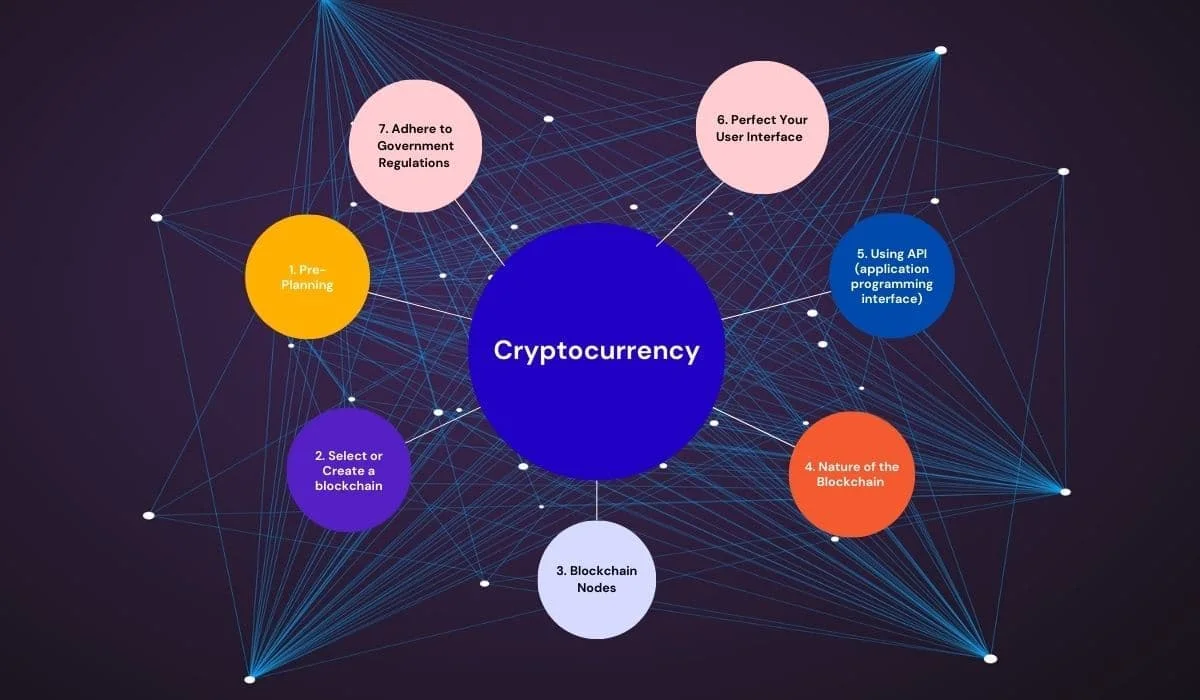Cryptocurrencies are decentralized currencies that can be used for peer-to-peer transactions. Currently, there are thousands of cryptocurrencies available in the world. Unlike traditional currencies, anyone with enough technical knowledge can create cryptocurrencies with minimal or zero investment.
With the technology getting exponentially better every year, the process of creating a cryptocurrency is not as complicated as it used to be back in the day. In this article, we will explore 7 easy steps for creating your own cryptocurrency. We will also cover the basics of cryptocurrency and blockchain technology, as well.
Key Takeaways
- Cryptocurrencies can be created by building a new blockchain, forking an existing one, or creating tokens on platforms like Ethereum or Solana.
- Successful cryptocurrencies require thorough pre-planning, user-friendly interfaces, and unique purposes to stand out in the crowded market.
- Adherence to local government regulations is critical to ensure legal compliance and avoid potential issues.
Understanding Cryptocurrency and Blockchain Technology
Before jumping on to creating a cryptocurrency, you should have a basic understanding of blockchain technology and cryptocurrency.
Cryptocurrency is a digital asset that can be transferred without the need for a centralized third party such as a bank, cryptocurrencies use cryptographic techniques and public nodes to secure transactions. It utilizes blockchain technology to ensure transparency and immutability of the transactions.
A blockchain is a series of blocks. Each block contains cryptographic information about a set of transactions. The blockchain is stored in several nodes around the world, making it almost impossible to tamper and alter.
Methods of Creating a Cryptocurrency
There are multiple ways to create a cryptocurrency. The classic way is to create a new blockchain and then create its native cryptocurrency. Comparatively, there are two easier ways such as creating a fork (modification) of an existing blockchain and creating crypto tokens on a blockchain. Let’s learn about each technique:
- Creating a new blockchain: Creating a new blockchain and its native cryptocurrency, gives you the utmost freedom for determining the census mechanism, hash rate, transaction speed, and more. While this method is tantalizing, it requires a professional level of knowledge in computer technology and software development. It may also require more investment, as you have to pay for hosting and other infrastructures in the beginning. It can also be a highly labor-intensive procedure.
- Creating a fork of another blockchain: Open source blockchain can be split into an entirely different blockchain by changing the rules and governance protocols in the blockchain. This saves you from the intense technical labor required for creating a blockchain from the ground up. Although you can customize the forked chain to your liking you would be following the template of the original blockchain you are forking limiting the freedom.
- Creating tokens on an existing blockchain: Many blockchain networks including Ethereum, and Solana allow users to use their platform to create dApps (decentralized applications), and non-native cryptocurrencies. This is the easiest way to create a cryptocurrency.
Create a Cryptocurrency in 7 Steps

As we have mentioned in the previous parts, there are multiple methods to create a cryptocurrency. While the specific steps may vary according to the method you chose, it can be generally categorized into seven.
1. Pre-Planning
The obvious first step in creating a cryptocurrency is, pre-planning. You need to outline what your cryptocurrency is, its purpose, its governance mechanism, etc. To make a successful cryptocurrency, you need to offer unique user-centric purposes and services that can increase the adoption.
2. Select or Create a blockchain
You can either select an existing blockchain or create a new one that is suitable for your planned purpose. To create your blockchain, you might need a good command of the Python programming language, Javascript, and possibly HTML. The same might be needed for creating a fork and building a blockchain network by using an existing network’s source code.
The blockchains that allow you to create your own cryptocurrencies include Ethereum, BNB chain, Solana, Tezos, Stellar, and more. The transaction speed and cost vary according to the blockchain you are using.
3. Blockchain Nodes
Nodes are an integral part of a blockchain. They are machines with fast processing that can validate transactions and record the blockchain entirely. You need to determine who has access to nodes, where the nodes are hosted, what operating system is ideal, and which hardware should you choose. This can require a considerable amount of investment from your side. So, choose your nodes wisely.
4. Nature of the Blockchain
The nature of your Blockchain determines how users can interact with it. Some of the most popular types of blockchain technology include centralized, decentralized, and distributed architectures. The nature of the blockchain determines the openness and democratization of the network.
5. Using API (application programming interface)
In simple words, an API is software that facilitates the communication between two applications. Depending on the nature and purpose of your blockchain, you might need multiple APIs. It can provide information about a cryptocurrency, help you get real-world information and data, and pull publicly available information.
6. Perfect Your User Interface
The user interface is one of the most important aspects that could make or break your blockchain network. It doesn’t have to be too fancy, but it shouldn’t be too complicated. The more easy your user experience is, you have the better chance of attracting more users.
7. Adhere to Government Regulations
The legality of blockchain technology and cryptocurrencies varies according to the specific jurisdiction. Always adhere to the local government laws and regulations to avoid any legal actions.
Final Thoughts
There are multiple ways to create cryptocurrencies. In this article, we have seen the 7 steps involved in creating a new cryptocurrency. To create a successful cryptocurrency, you need to offer something unique that the existing hundreds or thousands of cryptocurrencies do not. You should also make it easy for the user and nodes to use your platform.

